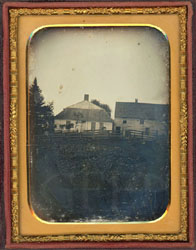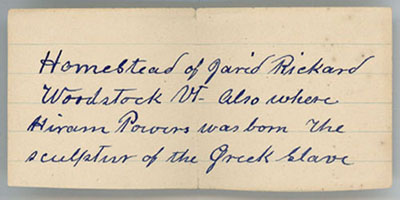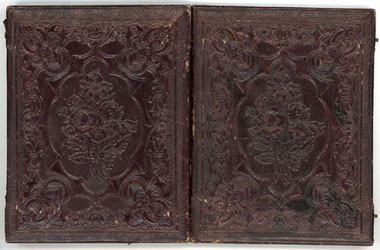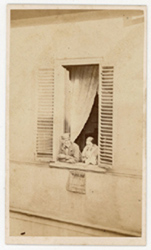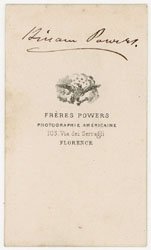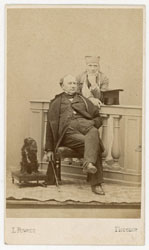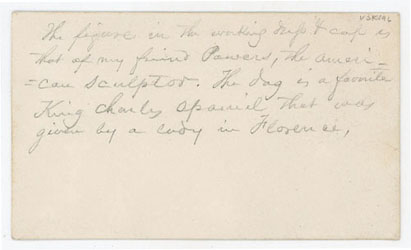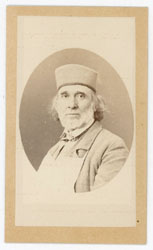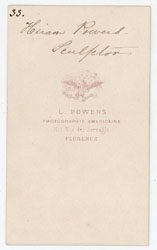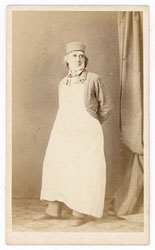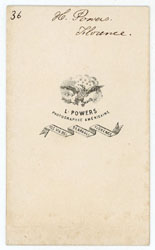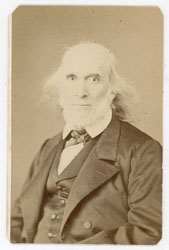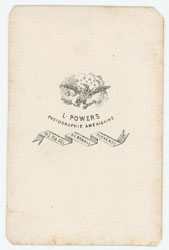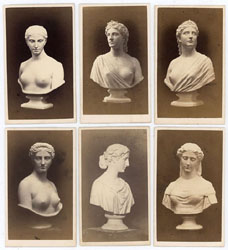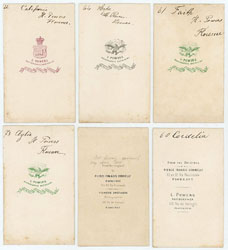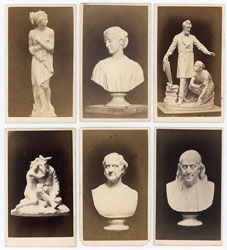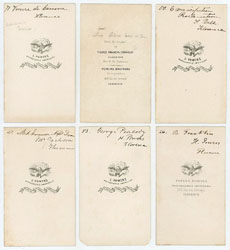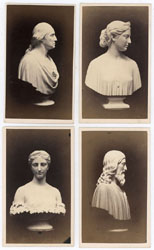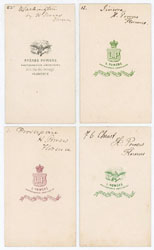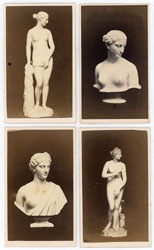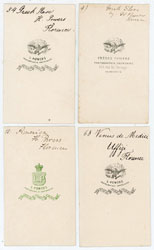HIRAM POWERS LOT: DAGUERREOTYPE OF VERMONT BIRTHPLACE,
5 CDV PHOTOS OF POWERS, 20 CDVs OF HIS SCULPTURES
$6000. USD
It's easy to go online and find photographs of Hiram Powers' birthplace. Therefore, validating the daguerreotype is easy. Of the five portrait CDVs, two are rare and seldom seen. Of these two rare CDVs, one features Powers with financier and philanthropist George Peabody. Four of the CDVs were taken by or assisted by Hiram's oldest son, Longworth Powers.
THE DAGUERREOTYPE. Depicts Hiram Powers' birthplace in Woodstock, Vermont. Comes with a note: "Homestead of Jared Rickard Woodstock Vt. Also where Hiram Powers was born the sculptor of the Greek Slave."
SIZE. Quarter plate.
HOUSING. Full case with some wear.
CONDITION. Bad glass replaced with hand-cut, high-quality, borosilicate glass by Derek French. Resealed. Brown spots in the sky and in the foreground. We treated it with water only. Mat abrasions at the bottom and left edge.
THE CDV (CARTE DE VISITE) PHOTOGRAPHS. As mentioned above, five CDVs feature Hiram Powers. Of these five: three are solo portraits, one features him with George Peabody, and one features him with someone else. Twenty CDVs feature various sculptures by Powers.
SIZE. CDVs are approximately 4 x 2 1/2 inches each. Some of these may be slightly smaller, some may be slightly larger.
CONDITION. As seen in the scans. Generally, good to very good. Please see and scrutinize the scans before purchasing.
HIRAM POWERS (1805 - 1873). "Hiram Powers' career began with his employment at a museum of mechanical wax figures in Cincinnati, Ohio. His family had moved there from Woodstock, Vermont, where he was born. Powers' wax figures were so lifelike that women are said to have fainted. Modeling figures in wax led to his decision to become a sculptor, and with the support of patron Nicholas Longworth, Powers' career flourished. Longworth sponsored Powers' trip to Washington, DC, where the young artist made his reputation with a marble bust of Andrew Jackson (1835, The Metropolitan Museum of Art). This work was much admired for its realism, and Powers received commissions to portray many other public figures. Andrew Jackson, John Quincy Adams, and Daniel Webster were among the famous American statesmen whose portraits he modeled. Powers was equally skilled at carving statues in the popular neoclassical style, based on ideals of beauty of ancient Greek and Roman sculpture. His 1843 neoclassical sculpture The Greek Slave was shown throughout America on a highly successful tour. It established him as one of the country's greatest sculptors. Like many American artists in the nineteenth century, Powers knew he could learn much from the paintings and sculpture to be seen in Europe. In 1837 he settled in Florence, Italy. His portrait busts were greatly admired and sought after; between 1842 and 1855 Powers completed 150 of them. He produced both realistic and idealized classical works until his death in Florence in 1873. Powers was one of the most successful and highly regarded American sculptors of the nineteenth century. From the 1830s on, several American sculptors achieved international fame; Powers stood out among them with his talent for creating both portraits in marble and images of classical purity." (source: National Gallery of Art website)
LONGWORTH POWERS (1835 - 1904). "The eldest son of the sculptor Hiram Powers (1805-1873), Nicholas Longworth Powers struggled to establish a career and failed to persevere at any task for long, a fact that continually frustrated his successful father. Longworth enrolled at the United States Military Academy at West Point, where his family hoped that the education and discipline would keep him in line, but he was asked to leave after only one semester. He then attended Rensselaer Polytechnic Institute in New York, but failed to stay long enough to earn a degree. His father thought Longworth might do better in Florence, Italy, where the Powers family had moved in 1837, and put him to work as a bookkeeper in his studio while teaching him the basics of sculpture. Longworth created a few portrait busts and ideal pieces, but his interest soon waned, and Hiram sent him back to America. By 1860, Longworth was back in Florence working as a photographer, creating portraits of prominent men and women in the city." (source: Smithsonian American Art Museum website)
